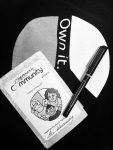Writing A Vision Of Success
3 tips for writing a vision of success from Kat Gordon, Professional Pie Taster & Owner at Muddy’s Bake Shop in Memphis, TN, and a ZingTrain client.
“This isn’t a vision, it’s an illustrated to-do list… let’s try a second draft.”
No one can say this as kindly and with as much encouragement as Maggie Bayless can. (Maggie is ZingTrain’s Founder and Co-Managing Partner). She said it to me after reading my first “vision”… and I’m so grateful that she did.
Perhaps like you, my first efforts at writing a vision missed the point entirely; I still somehow managed to focus on things to accomplish rather than how accomplishing them might make me feel and the impact they would create. Maggie gently taught me how important it is to first,
recognize “to-do list syndrome” and second, ask myself “why did I write this? what do I
think this will do for me or others?”.
Related: Why Writing a Company Vision and How to Get Started
I still tend to fill my first draft visions with to-do’s, but now I easily recognize them and
ask “why?”, then use my answers to inform my new draft. The result is a much truer
vision that reflects what deeply matters to me, not the first method for achieving it that
came to my imagination.
That’s maybe the single most important thing I’ve learned about writing a vision—ask “why?” until you get to the heart of the matter… and then re-draft.
In my five or so years of visioning I’ve learned a lot of lessons like this and adapted the tool to fit how I think, process ideas, and lead others. Here are three more of my favorite lessons learned:
1. Start small.
Visioning is a stupendous tool to get a team rowing in the same direction and involve
others from around the organization… however, I was much too quick to come home
from my vision class gung-ho to write a group vision for my business.
Yes, my team got super excited to participate. Yes, the long term company vision written by 40-something “gnomies”, as we call ourselves, sounds inspiring and full of pep.
However, if I’d taken the time to practice writing and realizing a few visions on my
own and then writing and realizing some group visions on smaller projects, I guarantee
that our long-term company vision would have turned out very differently and probably much more rooted in who we really are. If I could turn back time, I’d practice using this powerful tool both personally and organizationally before attempting a big, bold long-term company vision with all my coworkers.
Activity: Write one short term “mini-vision” for a home project, vacation, or event.
2. When considering multiple opportunities, write multiple visions.
Remember those Choose Your Own Adventure books where you, the reader, had to
make choices about where the story goes next? You can do this with visioning, too!
I call it “alternate endings,” and I do it frequently when I have multiple opportunities in
front of me or feel that I’m at a crossroads. Giving myself the freedom to explore what
the future may look like down various paths is liberating and allows me to play with a
variety of possibilities.
It also helps me feel that I’ve properly investigated alternatives; a frequent pitfall of visioning for me is that sometimes the first thing I think of after I’ve practiced hot-pen (writing non-stop for 15 minutes, without editing yourself along the way) becomes anchored in my mind—I feel that’s the only way to get where I want to go. Writing a variety of options (some realistic and some deliberately “off-the-wall”) loosens up my brain and gets me thinking differently.
It’s also helpful to read multiple “realities” and identify common themes. Maybe during the multiple hot-pen sessions, I wrote about 4 different paths for a business project, but they all have a few core things in common—that’s game-changing and really helpful in finding the truly important pieces that I need to be aware of on whatever path I choose.
Activity: Identify one path that has multiple outcomes; try hot-penning what the future
looks like in each possible “adventure”!
3. Don’t be surprised by the “Vision Hangover”.
You’ve written a vision and it’s splendiferous! You can taste, smell, hear, and see your
bright new future and you are energized to get there!
The next morning you wake up in your same bed, same house, same old reality… you’ve seen Oz in all its technicolor glory, but now you’re back in Kansas. It’s the same as before, only now you’re aware that it’s a washed-out, drab monotone of black, white and grey.
Ugh. You’ve got a massive Vision Hangover.
Some ways to remedy the Vision Hangover:
- Mindfully appreciate what’s around you and where you are: write a thank you letter to
someone, list a few things you’re proud of, take a long walk, journal for five minutes, practice meditation or centering prayer. - Get out of your comfort zone; stay limber to new experiences to help build the muscle you’ll need to get from current reality to vision. Take an art class, try Zumba, listen to a podcast about astronomy… learn something new!
- Recognize that you’re experiencing a Vision Hangover. Acknowledge it and intentionally keep your momentum going while appreciating all the great things you do have going on in your life and current reality!
Activity: List 20 positives that you love about your life/job/whatever as it is right now!
Happy visioning, y’all!
—–
Considering writing a vision of success for yourself or your organization? You might find these resources helpful:
How to Write a Vision of Success
New to Visioning? Read this first…
The Power of Visioning
What’s A Vision




Zingerman’s Art for Sale